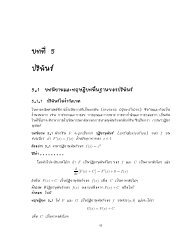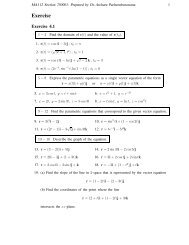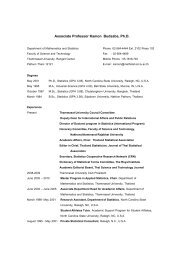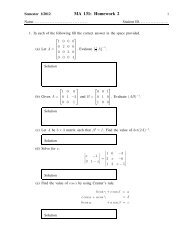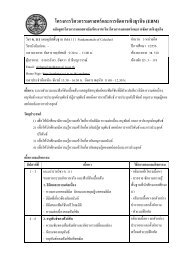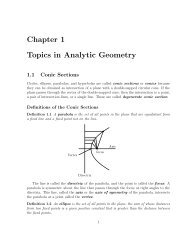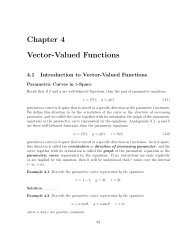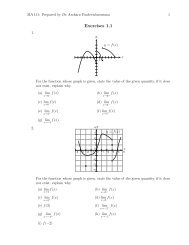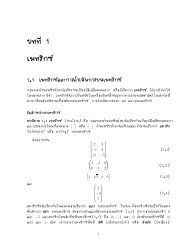Chapter 1 Topics in Analytic Geometry
Chapter 1 Topics in Analytic Geometry
Chapter 1 Topics in Analytic Geometry
You also want an ePaper? Increase the reach of your titles
YUMPU automatically turns print PDFs into web optimized ePapers that Google loves.
MA112 Section 750001: Prepared by Dr.Archara Pacheenburawana 12andx ′ = rcos(α), y ′ = rs<strong>in</strong>(α) (1.13)Apply<strong>in</strong>g the addition formulas for the s<strong>in</strong>e and cos<strong>in</strong>e, the relationships <strong>in</strong> (1.12) can bewritten asx = rcosθcosα−rs<strong>in</strong>θs<strong>in</strong>αy = rs<strong>in</strong>θcosα+rcosθs<strong>in</strong>αand on substitut<strong>in</strong>g (1.13) <strong>in</strong> these equations we obta<strong>in</strong> the follow<strong>in</strong>g relationships calledthe rotation equations:x = x ′ cosθ−y ′ s<strong>in</strong>θ(1.14)y = x ′ s<strong>in</strong>θ +y ′ cosθExample 1.11 Suppose that the axes of an xy-coord<strong>in</strong>ate system are rotated through anangle of θ = 45 ◦ to obta<strong>in</strong> an x ′ y ′ -coord<strong>in</strong>ate system. F<strong>in</strong>d the equation of the curve<strong>in</strong> x ′ y ′ -coord<strong>in</strong>ates.Solution .........x 2 −xy +y 2 −6 = 0If the rotation (1.14) are solved for x ′ and y ′ <strong>in</strong> terms of x and y, we obta<strong>in</strong>:x ′ = xcosθ +ys<strong>in</strong>θy ′ = −xs<strong>in</strong>θ+ycosθ(1.15)Example 1.12 F<strong>in</strong>d the new coord<strong>in</strong>ates of the po<strong>in</strong>t (2,4) if the coord<strong>in</strong>ate axes are rotatedthrough an angle of θ = 30 ◦ .Solution .........Elim<strong>in</strong>at<strong>in</strong>g the Cross-Product TermIn Example 1.11, we were able to identify the curve x 2 −xy+y 2 −6 = 0 as an ellipse becausetherotationof axes elim<strong>in</strong>ate the xy-term, thereby reduc<strong>in</strong>g the equation to a familiar form.This occurred because the new x ′ y ′ -axes were aligned with the axes of the ellipses. Thefollows theorem tells how to determ<strong>in</strong>e an appropriate rotation of axes to elim<strong>in</strong>ate thecross-product term of a second-degree equation <strong>in</strong> x and y.Theorem 1.1 If the equationAx 2 +Bxy +Cy 2 +Dx+Ey +F = 0 (1.16)is such that B ≠ 0, and if an x ′ y ′ -coord<strong>in</strong>ate system is obta<strong>in</strong>ed by rotat<strong>in</strong>g the xy-axesthrough an angle θ satisfy<strong>in</strong>gcot2θ = A−C(1.17)Bthen, <strong>in</strong> x ′ y ′ -coord<strong>in</strong>ates, Equation (1.16) will have the formA ′ x ′2 +C ′ y ′2 +D ′ x ′ +E ′ y ′ +F ′ = 0



